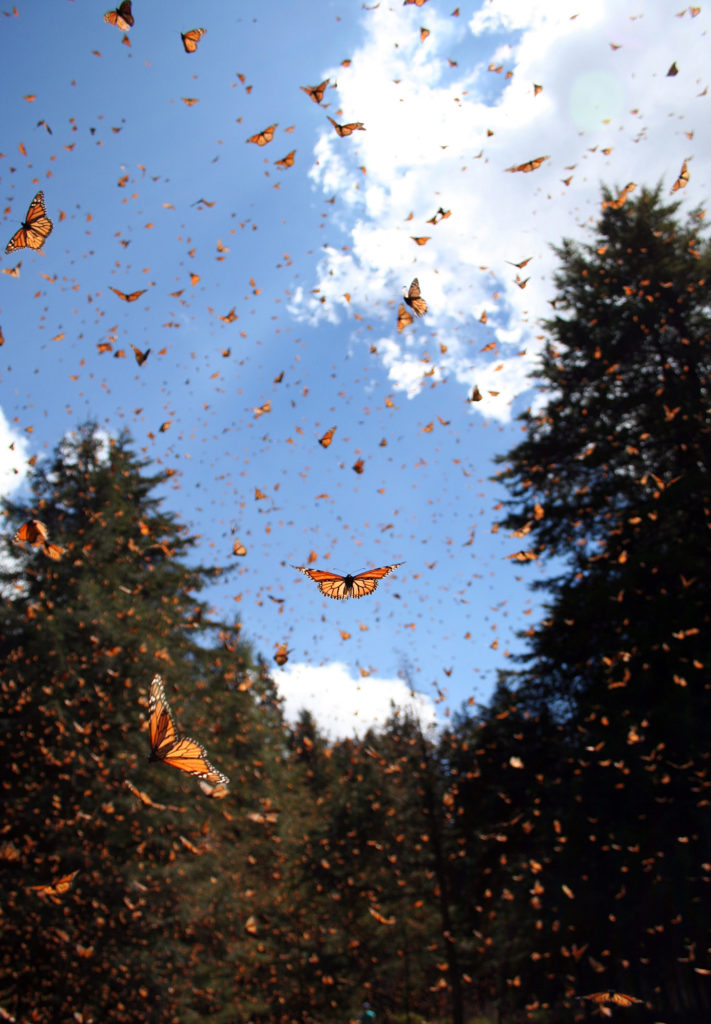Athens, Ga. – With their distinctive orange wings, remarkable long-distance migration and widespread presence, monarch butterflies are some of the most recognizable butterflies in the world. A team of researchers, led by scientists at the University of Chicago and including University of Georgia ecologist Sonia Altizer, has published a study in Nature that reveals unexpected answers to the origins of monarchs and the genetic basis of their best-known traits.
“The results of this study shift our whole thinking about these butterflies,” said the paper’s senior author Marcus Kronforst of the University of Chicago.
The scientists analyzed the genomes of nearly 100 monarchs from around the world to explore questions about the monarch’s evolutionary history and characteristic traits—where it originated, what genes determine its migratory behavior and what causes its bright orange warning coloration. What they learned surprised them, and underscored the importance of efforts to conserve North America’s migratory monarchs, whose numbers are declining.
They started their study by looking at the monarch’s evolutionary history. Analyses were based in part on butterflies from Altizer’s collection.
“The monarch is an outlier,” said Altizer, associate dean of the Odum School of Ecology and UGA Athletic Association Professor in Ecology. “Other species in the same genus and in the same subfamily as monarchs are generally tropical butterflies that have fairly restricted geographic ranges, while monarchs have a very broad modern geographic range and can migrate tremendous distances. Yet nobody understood the historical connection between these different monarch populations around the globe.”
They expected the genetic analysis to show that, like Neotropical birds, monarchs originated in the tropics and later expanded into North America and became migratory. Instead, they found just the opposite.
“For monarchs, the migratory North American population appears to be ancestral to all other modern populations,” Altizer said. “It appears to have given rise to the current populations in the New World tropics and in Europe and in the Pacific.”
The researchers also wanted to discover the genetic basis for migratory behavior. The component of the monarch genome that appeared to show the strongest link to long-distance migration was a gene that affects the structure and function of flight muscles—a gene very different from one that predicts dispersal propensity in other butterflies.
Finally, they looked for the genetic basis for the warning coloration of monarch wings by comparing the DNA of a small group of rare white monarchs from Hawaii with the more common orange ones found elsewhere. Again, their results ran counter to expectations. Instead of genes that affect the production of orange and red pigment causing the difference, it was a gene that affects the ability of the pigment to spread across the wing.
Altizer said she hopes that by pointing out the unique evolutionary history and genetic composition of the North American monarch population, the paper will add urgency to habitat conservation efforts.
“Monarchs have been in the news a lot lately because of their declines,” she said. “Some of the attention has focused on agricultural land use in this country and how that’s evaporating breeding habitats for these butterflies. We need to take a close look at how we grow food, and whether we want to make room for species like monarchs when we do that. The reality is that this population and the migratory phenomenon could be lost in our lifetimes if we don’t make some major changes to protect their habitats.”
The monarch butterfly has been studied for decades, but until recently the genetic tools needed to answer fundamental questions about its biology were not available.
That changed in 2011 when researchers at the University of Massachusetts Medical School, including the current paper’s lead author Shuai Zhan and coauthor Steven M. Reppert, published the monarch butterfly genome. Zhan, now on the faculty of the Shanghai Institutes of Biological Sciences, was previously a postdoctoral fellow at the University of Chicago.
Altizer and coauthor Jacobus de Roode of Emory University had been sampling monarchs from around the world to study the distribution of a parasite that infects them. At the University of Chicago, Kronforst was studying the genetics of monarch migration, as were researchers at the University of Massachusetts. Together, they teamed with colleagues in Europe and Australia to undertake a global analysis of monarch evolutionary history and the genetics behind migratory behavior and wing color.
“This paper shows that the monarch populations in North America that migrate are something special, in terms of their genetic composition and their history,” Altizer said. “We really need to care about protecting them.”
The paper’s other coauthors are Wei Zhang of the University of Chicago, Kristjan Niitepõld and Jeremy Hsu of Stanford University, Juan Fernández Haeger of the Univesidad de Córdoba and Myron P. Zalucki of the University of Queensland. The research was funded through a grant from the National Institutes of Health under award number GM086794-02S1, the National Science Foundation and Neubauer Funds from the University of Chicago.
